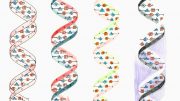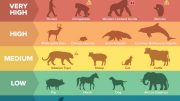
The Zoonomia Project has identified key parts of the human genome that have remained unchanged for millions of years, shedding light on disease susceptibility and unique mammalian traits. The findings, involving a comparison of 240 mammalian species, offer potential for improved disease understanding and biodiversity conservation.
Studies from the Zoonomia Project pinpoint key parts of the human genome that have remained unchanged after millions of years of evolution and may shed light on disease and unusual traits.
Over the past 100 million years, mammals have adapted to nearly every environment on Earth. Scientists with the Zoonomia Project have been cataloging the diversity in mammalian genomes by comparing DNA sequences from 240 species that exist today, from the aardvark and the African savanna elephant to the yellow-spotted rock hyrax and the zebu.
This week, in several papers in a special issue of of the journal Science, the Zoonomia team has demonstrated how comparative genomics can not only shed light on how certain species achieve extraordinary feats, but also help scientists better understand the parts of our genome that are functional and how they might influence health and disease.
In the new studies, the researchers identified regions of the genomes, sometimes just single letters of DNA, that are most conserved, or unchanged, across mammalian species and millions of years of evolution — regions that are likely biologically important. They also found part of the genetic basis for uncommon mammalian traits such as the ability to hibernate or sniff out faint scents from miles away. And they pinpointed species that may be particularly susceptible to extinction, as well as genetic variants that are more likely to play causal roles in rare and common human diseases. The findings come from analyses of DNA samples collected by more than 50 different institutions worldwide, including many from the San Diego Wildlife Alliance, which provided many genomes from species that are threatened or endangered.
More than 150 people across seven time zones have contributed to the Zoonomia Project, which is the largest comparative mammalian genomics resource in the world. The effort is led by Elinor Karlsson, director of the vertebrate genomics group at the Broad Institute of MIT and Harvard and a professor of bioinformatics and integrative biology at the UMass Chan Medical School, and Kerstin Lindblad-Toh, scientific director of vertebrate genomics at the Broad and a professor of comparative genomics at Uppsala University in Sweden.
“One of the biggest problems in genomics is that humans have a really big genome and we don’t know what all of it does,” said Karlsson. “This package of papers really shows the range of what you can do with this kind of data, and how much we can learn from studying the genomes of other mammals.”
From the Zoonomia Project — the largest comparative genomics resource in the world — comes a package of papers that compare the genomes of 240 mammals. DNA samples were collected by more than 50 different institutions worldwide including the San Diego Wildlife Alliance, which provided many genomes from species that are threatened or endangered. The findings help illustrate how comparative genomics can not only shed light on how certain species achieve extraordinary feats, but also help scientists better understand the parts of our genome that are functional and how they might influence health and disease. In this feature video, Dr. Elinor Karlsson and Dr. Kerstin Lindblad-Toh describe the project and what they hope to learn. Credit: Broad Institute of MIT and Harvard
Exceptional traits
In one of the studies published today, co-first authors Matthew Christmas, a researcher at Uppsala University, and Irene Kaplow, a postdoctoral researcher at Carnegie Mellon University, along with Karlsson, Lindblad-Toh, and collaborators, found that at least 10 percent of the human genome is highly conserved across species, with many of these regions occurring outside of protein-coding genes. More than 4,500 elements are almost perfectly conserved across more than 98 percent of the species studied.
Most of the conserved regions — which have changed more slowly than random fluctuations in the genome — are involved in embryonic development and regulation of RNA expression. Regions that changed more frequently shaped an animal’s interaction with its environment, such as through immune responses or the development of its skin.
The researchers also pinpointed parts of the genome linked to a few exceptional traits in the mammalian world, such as extraordinary brain size, superior sense of smell, and the ability to hibernate during the winter.
With an eye toward preserving biodiversity, the researchers found that mammals with fewer genetic changes at conserved sites in the genome were at greater risk for extinction. Karlsson and Lindblad-Toh say that even having just one reference genome per species could help scientists identify at-risk species, as less than 5 percent of all mammalian species have reference genomes, though more work is needed to develop these methods.
Disease insights
In another study, Karlsson, Lindblad-Toh, and colleagues used the mammalian genomes to study human traits and diseases. They focused on some of the most conserved single-letter genomic regions uncovered in the first paper and compared them to genetic variants that scientists have previously linked to diseases such as cancer using other methods.
The team found that their annotations of the genome based on evolutionary conservation revealed more connections between genetic variants and their function than the other methods. They also identified mutations that are likely causal in both rare and common diseases including cancer, and showed that using conservation in disease studies could make it easier to find genetic changes that increase risk of disease.
The co-first authors of this study were Patrick Sullivan, director of the Center for Psychiatric Genomics at the University of North Carolina Medical School, Chapel Hill and a professor of psychiatric genetics at Karolinska Institutet in Sweden; Jennifer Meadows, a genetics researcher at Uppsala University in Sweden; and Steven Gazal, an assistant professor of population and public health sciences at the Keck School of Medicine at the University of Southern California.
A world of questions
A third study, co-led by Steven Reilly, an assistant professor of genetics at Yale University, and Pardis Sabeti, an institute member at the Broad, examined more than 10,000 genetic deletions specific to humans using both Zoonomia data and experimental analysis, and linked some of them to the function of neurons.
Other Zoonomia papers published today revealed that mammals diversified before the mass dinosaur extinction; uncovered a genetic explanation for why a famous sled dog from the 1920s named Balto was able to survive the harsh landscape of Alaska; discovered human-specific changes to genome organization; used machine learning to identify regions of the genome associated with brain size; described the evolution of regulatory sequences in the human genome; focused on sequences of DNA that move around the genome; discovered that species with smaller populations historically are at higher risk of extinction today; and compared genes between nearly 500 species of mammals.
For Karlsson, Lindblad-Toh, and the researchers who have been sequencing mammalian genomes for Zoonomia or its precursor projects since 2005, these studies — and the breadth of questions they answer — are only a fraction of what is possible.
“We’re very enthusiastic about sequencing mammalian species,” said Lindblad-Toh. “And we’re excited to see how we and other researchers can work with this data in new ways to understand both genome evolution and human disease.”
Reference: “Zoonomia” by Sacha Vignieri, 27 April 2023, Science.
DOI: 10.1126/science.adi1599








There are many fascinating finds out of this. But to me the most interesting phylogenetic tree result is that Afrotheria (with elephants, for example) and Xenarthra (with sloths, for example) are sister lineages. They seem to have diverged as Africa and South America split up Gondwanaland between them, 100+ million years ago.